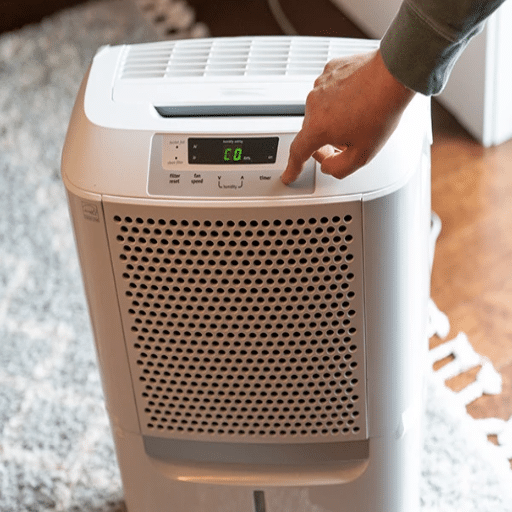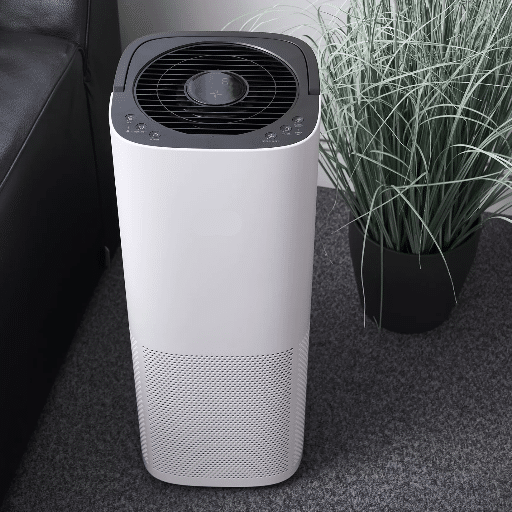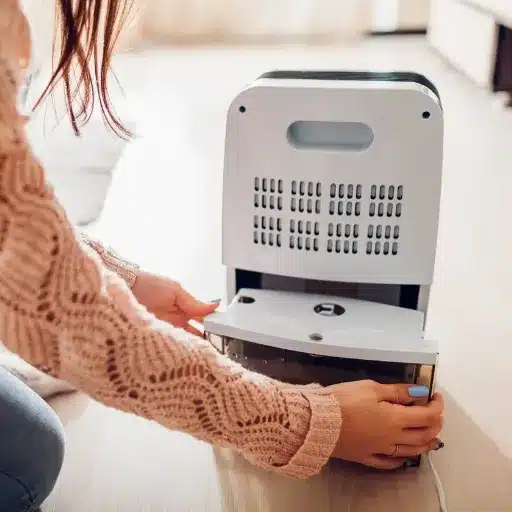Causes of Ice Buildup on Dehumidifiers

Ice accumulation on dehumidifiers happens when the temperature in the surrounding area drops too low, usually below 65°F (18°C). Dehumidifiers inhale air to remove moisture, but in the case of very cold air, the moisture gets frozen on the evaporator coils instead of dripping down into the water reservoir.
Primary Causes of Ice Formation
- Low Temperature: Operating the unit in environments below 65°F (18°C) causes moisture to freeze on the coils rather than drain properly
- Restricted Airflow: A filthy or blocked air filter limits airflow, which might lead to the coils cooling excessively
- Refrigerant Issues: Insufficient refrigerant can disrupt the normal operation of the unit
- Defective Components: A broken thermostat or humidistat can cause ice to form
Key Temperature Threshold
Most dehumidifiers have a specific temperature range, usually above 65°F (18°C), and are designed to function efficiently within this range. Operating below this threshold significantly increases the risk of ice formation.
Solutions to Prevent Ice Buildup
It is very important to maintain the dehumidifier and use it in the right conditions to avoid ice buildup. Here are the most effective prevention strategies:
Essential Prevention Measures
- Maintain Proper Temperature: Position the unit in a room where it is warmer than 65°F to help guarantee that it runs properly
- Regular Filter Maintenance: Clean or change air filters regularly to create a pathway for airflow, which in turn will lead to a reduction in freezing
- Choose the Right Model: If operating in a colder zone, consider a unit with a defrost feature that automatically melts any ice on the coils
- Schedule Regular Inspections: Regular servicing can detect problems like leaking refrigerants or malfunctioning components before they result in huge ice build-up
Understanding Dehumidifier Ice Formation
Dehumidifier operation may get interrupted when it encounters the problem of ice formation, thus it would not be able to perform its function of moisture removal from the air effectively. Recent search trends and data reveal several contributing factors:
| Factor | Impact | Solution |
|---|---|---|
| Low Temperature | Moisture freezes on coils instead of draining | Maintain room temp above 65°F |
| Poor Airflow | Restricted movement makes operation inefficient | Clean filters and coils regularly |
| Low Refrigerant | Disrupts cooling system and temperature control | Professional refrigerant inspection/recharge |
| Defective Components | Prevents ideal temperature maintenance | Replace faulty sensors and thermostats |
Impact of Temperature and Humidity Levels
Temperature and humidity are two factors that have a significant and interactive effect on the environment and the dehumidification system’s performance.
Optimal Operating Conditions
- Indoor Temperature: 65–85°F (18–30°C)
- Relative Humidity: 30–50%
This equilibrium reduces the probability of frost formation while increasing the longevity of the system and cutting down on energy costs.
Dehumidifier Freeze: Symptoms and Effects
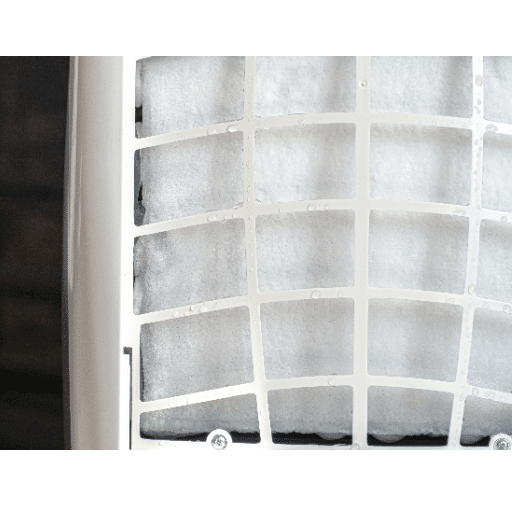
Symptoms of Dehumidifier Freeze
Dehumidifier freeze is a frequent problem that occurs when evaporator coils are operated under unfavorable conditions. Major indicators include:
- Visible Frost or Ice: Build-up on coils that can be seen, which reduces the power of the dehumidifier to remove moisture
- Reduced Water Collection: Very slight increase in water collection even when the humidity level remains constant
- Strange Sounds: Fan or compressor making unusual noises due to limited airflow
- Increased Energy Consumption: Device works ineffectively, drawing more power
- Complete Shutdown: System can no longer maintain functioning if freezing continues
Effects of Dehumidifier Freeze
The freeze of a dehumidifier has efficiency issues not only as outright operational inefficiencies but also long-term consequences:
- Mechanical Strain: Ice on evaporator coils increases load on the compressor, accelerating wear
- Reduced Lifespan: Continuous freezing drastically reduces the unit’s operational life
- Blocked Airflow: Ice buildup can block airflow completely, creating a vicious cycle
- Higher Energy Bills: Prolonged run time and decreased efficiency levels significantly increase costs
- Component Damage: May suffer irreparable internal damage requiring costly repairs or replacement
⚠️ Consequences of Neglect
Neglecting a frozen dehumidifier might lead to increased mold and mildew as a consequence of undeterred humidity, which will also be a health hazard. Regular maintenance like filter cleaning and ambient temperature checking should be done to prevent negative effects.
Troubleshooting Ice Issues on Your Dehumidifier
Dehumidifier ice formation is normally the consequence of environmental or operational factors that interfere with the device’s proper functioning.
Main Reasons for Ice Accumulations
| Issue | Description | Action Required |
|---|---|---|
| Low Room Temperature | Operating below 65°F (18°C) | Use units with anti-freeze feature or heat the area |
| Limited Airflow | Dirty air filter restricting airflow | Clean and replace filters per manufacturer guidance |
| Refrigerant Problems | Leakages causing uneven cooling | Professional servicing for inspection and charging |
| Defective Thermostat | Misreading ambient temperature | Test and replace temperature sensors |
Ice Troubleshooting and Resolution Steps
- Unit Shutdown: When ice is found, switch off the device immediately to stop further internal component damage. Restart only after ice has melted completely
- Evaluate Surroundings: Determine room temperature and match it with the dehumidifier’s operation range. Use external heaters if needed
- Check Parts: Remove air filter and other accessible parts for cleaning and inspection. Look for damage or dust buildup
- Review Manual: Go through manufacturer’s instructions to verify correct settings and environmental suitability
- Professional Help: If problems continue, call a qualified technician or consider upgrading to an Energy Star-certified model
Steps to Diagnose Ice Problems
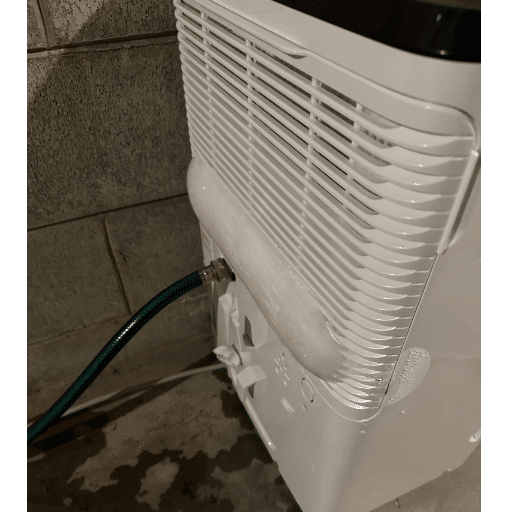
1. Check the Temperature of the Room
Start by checking the temperature where the dehumidifier is stationed. If the temperature is 65°F (18°C) or lower, freezing ice is highly likely. For colder areas, switch to low-temperature-compatible or Energy Star-certified models.
2. Consider Airflow and Ventilation
- Check air intake and exhaust vents for obstructions
- Ensure minimum 12 inches of clearance on all sides
- Clean dust, dirt, or debris buildup thoroughly
3. Inspect Coils for Dirt and Damage
The condition of evaporator coils can determine ice buildup size. Look intently at the coils and clean with a coil cleaner if needed. Physical damages like bends or punctures require professional intervention.
4. Check Humidity and Usage Settings
Recommended Settings:
- Set humidity to 40% to 50% range for most living areas
- Avoid unreasonably low settings (below 30%) which cause the system to work too hard
5. Examine the Defrost Functionality
Many dehumidifiers have an automated defrosting system. Run this feature through a few cycles. If it doesn’t activate or ice doesn’t clear, professional repair may be needed.
6. Check Refrigerant Levels
Low refrigerant levels create ice formation situations. This requires an HVAC technician, as refrigerant issues should only be handled by skilled workers with proper certification.
7. Check for Error Codes or Diagnostic Features
Most modern dehumidifiers have built-in diagnostic systems. Look up the user manual to interpret any error codes displayed and address them accordingly.
Defrosting Techniques for Your Unit
Manual Defrosting Process
- Power Down: Turn the unit off and unplug from the socket for safety
- Relocate: Move the device to a warmer place to speed up frost melting
- Allow Natural Melting: Wait for ice to melt completely (may take several hours)
- Gentle Cleaning: Use a damp cloth to gently wipe frost off coils
⚠️ Important Safety Note
Make sure not to use sharp tools or press hard as it might cause damage to the equipment. Never attempt to speed up the process with excessive force.
Automatic Defrost Feature
Many new models have automatic defrosting options that stop the compressor and keep the fan running to melt ice on the coils. If your model offers this feature, it will activate automatically under certain conditions.
When to Call a Professional for Help
There are scenarios where professional assistance is necessary to prevent more serious problems:
- Persistent Frost: Ice remains even with correct temperature, humidity settings, and regular maintenance
- Internal Component Failure: Malfunctioning compressor or temperature sensor
- Strange Noises: Unusual sounds indicating mechanical issues
- Reduced Efficiency: Machine getting noticeably less efficient over time
- Water Leaking: Signs of leakage that can’t be resolved through basic troubleshooting
Professional Advantage
Hiring HVAC-certified professionals ensures proper diagnosis and resolution with minimal time and input. They have the requisite skills to execute complicated repairs and prevent future breakdowns, saving time and resources in the long run.
Preventing Ice Build-Up on Dehumidifiers
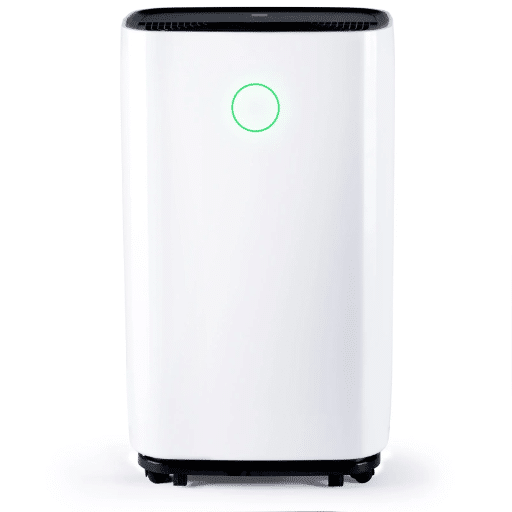
Key Prevention Strategies
| Prevention Method | Frequency | Benefit |
|---|---|---|
| Maintain proper temperature (above 65°F) | Continuous | Prevents primary cause of freezing |
| Clean filters | Every 2-3 weeks | Ensures proper airflow |
| Inspect evaporator coils | Every few months | Prevents ice accumulation |
| Maintain proper clearance (6-12 inches) | Always | Optimizes air circulation |
| Monitor humidity levels (30-50%) | Continuous | Prevents excess moisture |
Best Practices for Optimal Operation
Regular Maintenance Schedule
- Filter Cleaning: Every 2-3 weeks using light detergent and water. Ensure completely dry before reinstalling
- Water Tank: Empty, clean, and disinfect frequently to stop mold and bacteria growth
- Coil Cleaning: At least once every few months, or more frequently if ice build-up or reduced efficiency occurs
- Drain Hose: If equipped with continuous drainage, ensure hose is not blocked
Proper Placement Guidelines
- Position in the middle of the room with good airflow
- Maintain 6-12 inches distance from walls and furniture
- Ensure room is well-ventilated
- Avoid blocking air intake or exhaust vents
Optimal Indoor Conditions
According to recent search data, the ideal indoor humidity level is 30%-50%. Maintaining this range prevents structural damage caused by moisture and inhibits growth of dust mites and molds.
Importance of Proper Drain Hose Installation
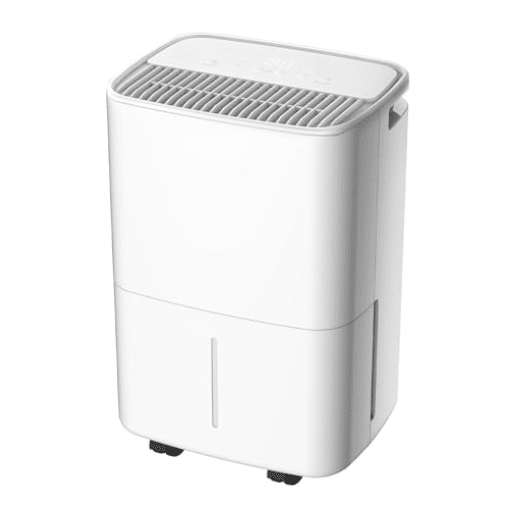
The dehumidifier operation’s efficiency largely depends on proper drain hose installation. Incorrect installation can cause water backup, malfunctions, spills, and unit damage.
Installation Best Practices
- Secure Connection: Ensure drain hose is tightly connected
- Proper Angle: Place hose slightly downward for easy water flow
- Avoid Kinks: No twists or bends that act as barriers to drainage
- Regular Cleaning: Check hose for clogs or blockages to prevent water accumulation
References
- Dehumidifiers – University of Michigan – A detailed explanation of how dehumidifiers work, including their role in managing moisture and preventing issues like icing.
- Icing Mitigation via High-pressure Membrane Dehumidifier – CORE Scholar – A research paper discussing the use of membrane dehumidifiers to mitigate icing in specific applications.
Frequently Asked Questions (FAQ)
What causes ice build-up on a dehumidifier?
Low room temperature, inadequate airflow, or a dirty air filter are the main reasons for ice build-up on a dehumidifier. When the temperature lowers, the cold coil might cause the moisture in the air to condense and freeze. Moreover, if the humidity sensor is not working properly, it may not be able to activate the defrost cycle, causing the ice to accumulate.
How can I troubleshoot my dehumidifier freeze issue?
To troubleshoot a dehumidifier freeze issue, check for dirt and debris in the filter, ensure that the coils are clean, and verify that the refrigerant charge is sufficient. If the room is too cold, you could move the unit to a warmer room or turn up the thermostat. It is also possible to do some checking to find out if there is an airflow problem that is diminishing the amount of air passing through the unit.
What should I do if my dehumidifier has ice on it?
If ice has formed on your dehumidifier, the first measure is to switch off the appliance and wait for it to completely thaw. This can take a few hours. After melting, clean the coils, check the filter, and look for any airflow problems before you turn on the unit again. Make sure the surroundings are right for operation, preferably at a warmer room temperature.
Can low refrigerant lead to ice build-up on my dehumidifier?
Yes, refrigerant shortage can cause improper heat transfer in the condenser coils which, in turn, can make the cold coil freeze up. The formation of ice will then occur because the air’s humidity is being condensed and frozen instead of being dried out properly. If you think that this is your problem, it’s best to call in an expert to evaluate the refrigerant levels.
How does humidity affect the defrost cycle of a dehumidifier?
A dehumidifier’s defrost cycle is determined by the humidity levels in the surrounding environment. If humidity is high, then more moisture is going to be condensing, which can easily result in ice on the coils. The sensor for humidity is very important in deciding when to commence defrosting as it helps the dehumidifier not only to work but also to be efficient in making the place less humid.
What are the signs of airflow problems in a dehumidifier?
The main indicators of a dehumidifier with airflow problems are poor moisture extraction, ice formation on the coils, and strange sounds coming from the appliance. The efficiency of the unit could be affected if airflow is restricted by, for example, a blocked drain hose or dirty filters. You may also want to check that the dehumidifier is not surrounded by furniture or other objects to the point of obstructing airflow.
Is it normal for a dehumidifier to freeze in cooler temperatures?
Though it may sometimes be seen as normal for a dehumidifier to freeze in cooler temperatures, it is still not a desirable situation. The majority of dehumidifiers work perfectly in a warmer environment. In case the temperature in the room is too low, look for a desiccant dehumidifier that is specifically made for colder areas or shift the unit to a place with higher temperature.
How often should I clean the coils of my dehumidifier?
Cleaning the coils of your dehumidifier should be done at least once every few months, or more frequently if you notice ice build-up or reduced efficiency. Keeping the coils clean allows for better heat exchange and prevents ice formation. Regular maintenance, including checking the filter and ensuring proper airflow, will help prolong the life of your unit.

